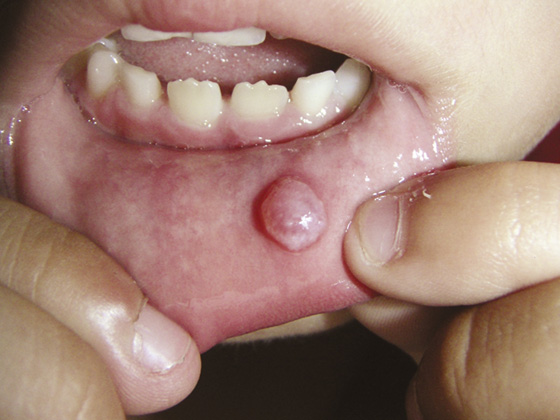CHAPTER 52
Mucocele
(Mucous Cyst)
Presentation
A patient may be alarmed by the rapid development of a soft, rounded, nontender, fluctuant cyst, most often found inside the lower lip. The cyst varies from 2 to 10 mm in diameter. The surface is made up of pearly or translucent mucosa. It is relatively painless or asymptomatic (Figure 52-1). The patient may be aware of previous recent or remote trauma to the lip, or he may have a habit of biting his lip.

Figure 52-1 Traumatic mucous cyst. (Copyright © Vilma Pineda, DDS, Dermatlas; http://www.dermatlas.org.)
What To Do:
 Reassure the patient that this is not a serious tumor.
Reassure the patient that this is not a serious tumor.
 Refer the patient to an appropriate oral surgeon who can perform laser ablation cryosurgery, electrocautery, or total cyst excision.
Refer the patient to an appropriate oral surgeon who can perform laser ablation cryosurgery, electrocautery, or total cyst excision.
 Alternatively, a micromarsupialization technique for mucoceles in pediatric patients has been reported. Place a 4-0 silk suture through the widest diameter of the dome of the lesion without engaging the underlying tissue. Tie a surgical knot, and leave the suture in place for 7 days, allowing a new epithelial-lined duct to form and providing egress of saliva from the obstructed minor salivary gland. The recurrence rate after this procedure was approximately 14% in pediatric patients.
Alternatively, a micromarsupialization technique for mucoceles in pediatric patients has been reported. Place a 4-0 silk suture through the widest diameter of the dome of the lesion without engaging the underlying tissue. Tie a surgical knot, and leave the suture in place for 7 days, allowing a new epithelial-lined duct to form and providing egress of saliva from the obstructed minor salivary gland. The recurrence rate after this procedure was approximately 14% in pediatric patients.
What Not To Do:
 Do not use the micromarsupialization technique on mucoceles that are larger than 1 cm in diameter.
Do not use the micromarsupialization technique on mucoceles that are larger than 1 cm in diameter.
 Do not simply unroof these lesions. They will typically recur.
Do not simply unroof these lesions. They will typically recur.
This cyst, which is of minor salivary gland origin, is caused by traumatic rupture of the mucous gland duct, with extravasation of sialomucin into the submucosa. It usually occurs inside the lower lip but may also occur under the tongue or in the buccal mucosa. These traumatic mucus-retention cysts rupture easily, releasing sticky, straw-colored fluid. Most mucoceles occur in young individuals, with 70% of individuals being younger than 20 years.

Full access? Get Clinical Tree



